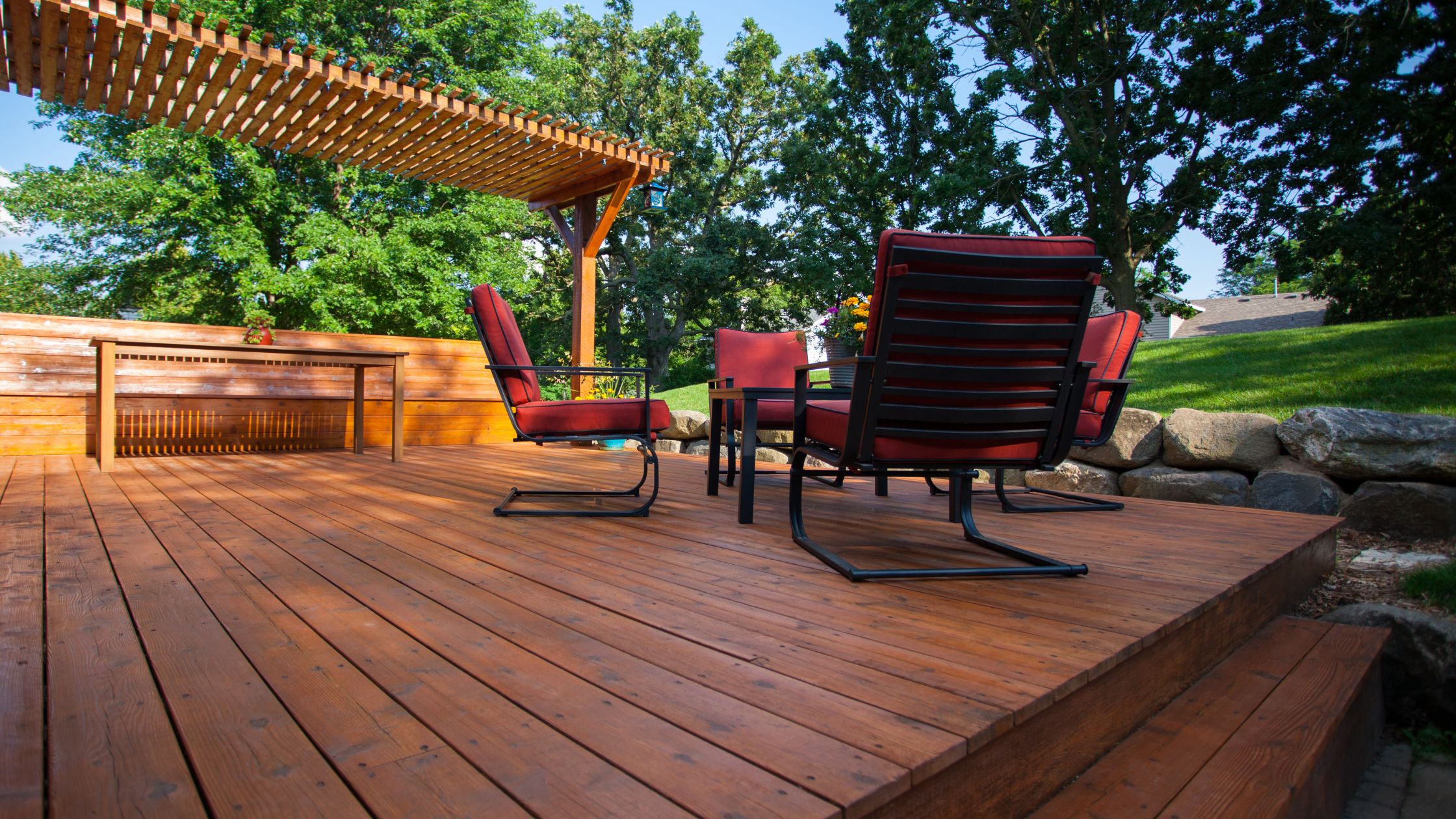
How Weather Affects Deck Stain Over Time
In Northeast Ohio, fluctuating temperatures, high humidity, UV exposure, and winter freeze-thaw cycles can seriously degrade your deck stain. Wood decks are especially vulnerable to peeling, fading, and water damage if not maintained properly. Even composite decks like Trex benefit from routine cleaning and protection. Knowing how local weather affects your deck—and taking proactive steps—can double its lifespan.
How Weather Affects Deck Stain Over Time (And How to Protect Your Deck in Northeast Ohio)
If you live in Northeast Ohio, your deck sees it all: freezing snow, blazing sun, muggy humidity, and plenty of rain in between. It’s not just the weather you feel—it’s what your deck stain battles every day.
Whether you have a traditional wood deck or a modern composite surface like Trex®, understanding how our local climate affects it can help you avoid costly repairs and get the most from your investment.
Let’s break it down by season and show you how to protect your deck year-round.
☀️ Summer: UV Damage and Heat Stress
Problem: Prolonged sun exposure and high humidity
Effect on stain:
-
Fading and discoloration from UV rays
-
Peeling or blistering when stain overheats
-
Mold/mildew growth in shady or poorly ventilated areas
In a Cleveland-area summer, it’s not unusual for temperatures to swing between 70°F and 90°F with high humidity. These conditions bake the surface and invite moisture to linger—creating the perfect recipe for mildew on railings and between deck boards.
How to protect your deck in summer:
-
Use UV-resistant stain or sealer with built-in sunblock (look for “semi-transparent” or “solid stain” with UV inhibitors)
-
Apply stain in the early morning or late afternoon when temperatures are below 80°F
-
Keep the deck clean and dry with regular sweeping and monthly washing
🍂 Fall: Leaf Debris and Moisture Traps
Problem: Falling leaves, debris buildup, cooler wet weather
Effect on stain:
-
Organic matter traps moisture and rots the finish
-
Water pools in grooves, encouraging peeling or bubbling
Once the leaves start falling in late September or October, it’s easy to let cleanup slide—but that can mean serious trouble for your deck finish.
Prevention tips:
-
Sweep weekly to prevent damp organic buildup
-
Trim trees and bushes that hang directly over the deck
-
Avoid covering your deck with plastic tarps that trap moisture—use breathable covers instead
❄️ Winter: Snow, Ice, and Freeze-Thaw Damage
Problem: Ice buildup, snow loads, freeze-thaw cycles
Effect on stain:
-
Water seeps into wood grain, expands when frozen, and cracks the finish
-
Salt-based deicers can strip or bleach stain
-
Prolonged coverage with snow can cause uneven fading
Wood is porous. In Northeast Ohio, where we see snow and freeze cycles from November through March, that means your deck surface is constantly expanding and contracting. Cheap stains or improperly applied coatings won’t survive more than a couple winters without peeling or lifting.
Protective strategies:
-
Clear snow with a plastic shovel, not metal, to avoid scratching the stain
-
Avoid salt—use pet-safe or deck-safe ice melt products
-
If possible, shovel before the thaw to minimize water absorption
🌱 Spring: Moisture Surge and Mold Growth
Problem: Rain, thaw, high moisture content in wood
Effect on stain:
-
Moist wood can’t hold stain properly, leading to uneven absorption
-
Algae and mold love wet wood—leading to green or black discoloration
Spring in Northeast Ohio is damp and unpredictable. Wood decks that haven’t been sealed in the last year or two will soak up moisture like a sponge, which can quickly lead to surface breakdown.
Key steps:
-
Inspect the deck in early spring for peeling, soft spots, or discoloration
-
Clean with a deck-safe mold and mildew remover
-
Let wood dry for 2–3 sunny days before applying stain or sealer
🪵 Trex & Composite Decks: Still Affected by Weather
While Trex and other composite decks don’t need staining, they’re not maintenance-free. UV rays, humidity, and freeze-thaw cycles can still cause:
-
Surface fading or discoloration
-
Mold/algae buildup in grooves or under leaves
-
Expansion and contraction that affects fasteners or joints
Maintenance tips for composite decks:
-
Wash every 1–2 months with a composite-safe cleaner
-
Gently scrub buildup with a soft brush (avoid power washers above 1500 PSI)
-
Avoid rubber mats that trap moisture
-
Inspect for loose screws or warped boards after winter
🧼 Regular Cleaning Is Your Best Defense
If you do one thing for your deck, make it regular cleaning. Dirt, leaves, and grime speed up every weather-related problem.
Quick Cleaning Checklist:
-
Monthly: Rinse with a garden hose or use a blower
-
Seasonally: Deep clean with a deck cleaner or pressure wash
-
Yearly: Reapply stain (for wood) or inspect fasteners (for composite)
🧰 Pro Tips for Maximizing Stain Life in Northeast Ohio
Here’s how to keep your wood deck stain looking great through the seasons:
-
Choose the right product: Use a high-quality stain rated for heavy UV and moisture exposure
-
Apply properly: Only stain when wood is fully dry (check with a moisture meter if unsure)
-
Refresh as needed: Don’t wait until the finish peels—restain every 2–3 years, or sooner if wear is visible
-
Use a breathable cover if storing furniture on the deck all winter
-
Fix drainage issues that cause puddling or splashing near deck edges
FAQs: Weather and Deck Stain in Northeast Ohio
How often should I restain my wood deck in Northeast Ohio?
Most decks in our area need new stain every 2–3 years, but high-traffic or high-sun areas may need it annually. Check for fading, water absorption, and peeling to know when it’s time.
Does humidity affect how stain dries?
Absolutely. High humidity slows down drying and can trap moisture under the stain, leading to poor adhesion or blotchy results. Aim for less than 60% humidity when staining.
Can I stain my deck in the fall?
Yes, early fall is actually a great time—cooler temps and lower humidity mean better drying conditions. Just be sure there’s no rain in the forecast for at least 48 hours.
Do I need to do anything special for composite decks in winter?
Shovel with care, use a non-metal shovel, and avoid traditional rock salt. Clean any leftover leaves or dirt before the snow falls to prevent mold buildup underneath.
What happens if I stain too soon after rain?
Staining too soon after rain is one of the most common reasons a deck stain fails prematurely—especially in Northeast Ohio, where weather changes quickly and humidity can stay high even after the skies clear.
When wood is still damp:
-
The stain can’t properly absorb into the wood fibers.
-
Moisture gets trapped beneath the surface, leading to blistering or peeling.
-
The finish may dry unevenly or remain tacky for days.
-
Mold and mildew are more likely to grow under the stain.
Even if the deck looks dry, it might still hold moisture deep inside. This is especially true in shaded areas, around fasteners, or on decks with poor airflow beneath. A good rule of thumb is to wait at least 24–48 hours of dry, sunny weather before staining—and even longer if it’s humid or the deck doesn’t get much direct sun.
Pro tip: Use a moisture meter to check the wood. Stain should only be applied when the moisture content is below 15%.
Staining too early risks wasting both your time and money—since the finish may need to be stripped and redone much sooner than expected. Always prioritize proper drying time to ensure your stain bonds correctly and lasts.




No Comments
Sorry, the comment form is closed at this time.